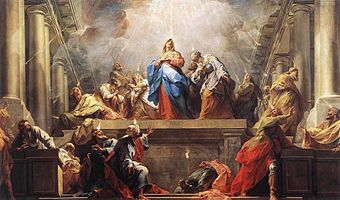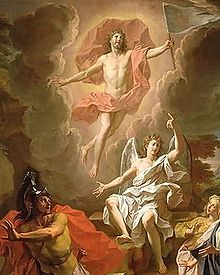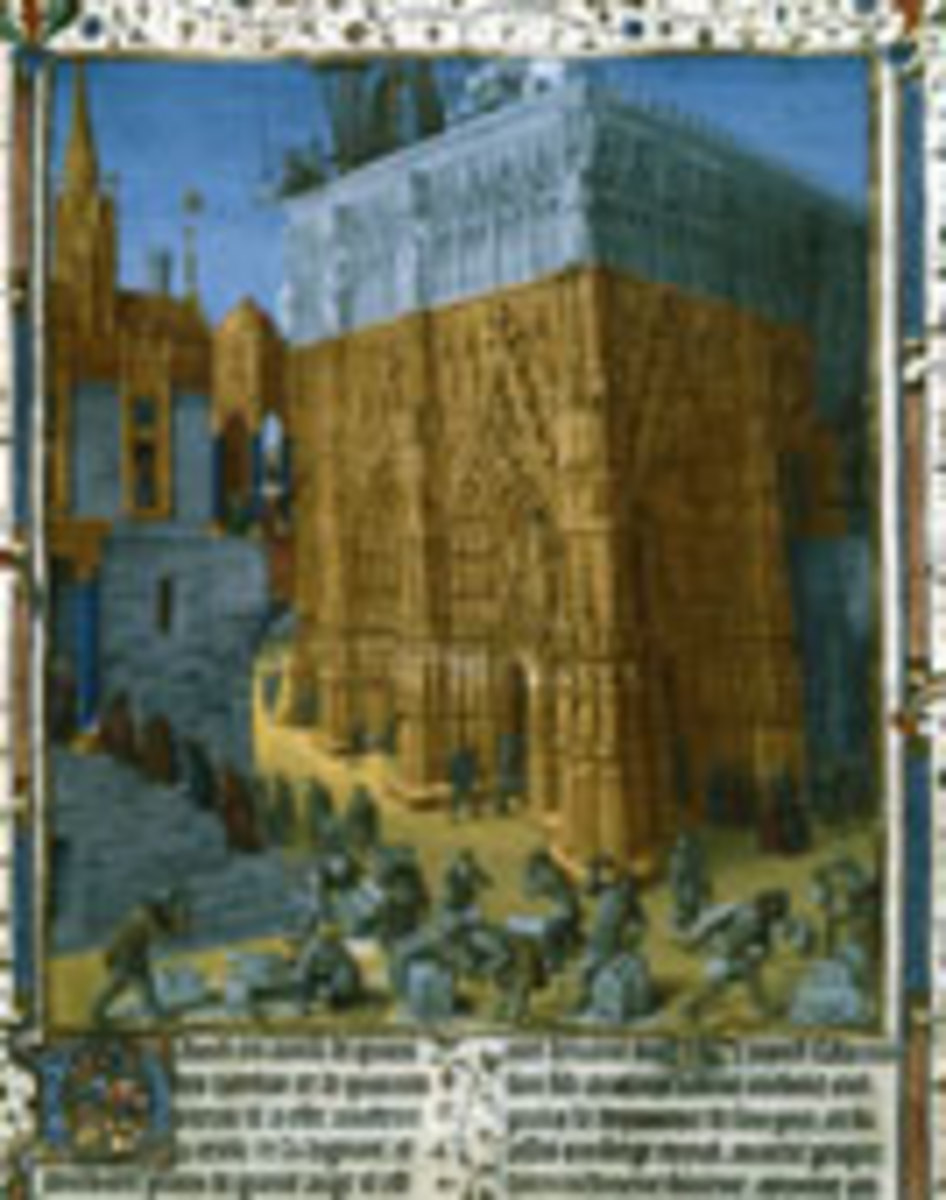Bible: What Does Acts 2:1-32 Teach Us About Pentecost?
The Coming of the Holy Spirit

Tongues: Still Given Today?
Do you believe that God is giving the miraculous sign gift of speaking in other languages?
Acts 2: 1-32-- The Birthday of the Church, the Body of Christ
The "Fiery Tongues Phenomenon" on Pentecost
As they were wont to do since the Ascension, the one hundred twenty disciples gather together in the upper room, this time on the Day of Pentecost [the Feast of Weeks (see 1:4ff) or the Ingathering of the Wheat Harvest, Ex. 23:16] (v. 1).
Suddenly, they hear a wind-like sound descending from the sky, and it fills both the upper room as well as the whole house (v. 2).
Then they all see a vision of tongues that looks like flames of fire distributing themselves among the crowd, one tongue resting upon each person (v. 3).
Luke informs the reader that the Holy Spirit—Who sent this sound resembling a windstorm to communicate to those assembled the uniqueness of the event transpiring—“fills” these people; His presence invades every compartment of each person’s life, just as the sound “filled the whole house” (v. 4a).
While assuming residence within them, the Spirit instanteously imparts to them the ability to speak in a human language (represented by the fiery tongue) that they did not previously know (v. 4b).
The One Hundred Twenty Speak to the Visitors to Jerusalem
Ryrie reasonably conjectures that the one hundred twenty left the house and entered the temple’s environs where devout male Jews from around the world had gathered, having heard the sound from heaven descending upon the city (vv. 5-6a).
[The Spirit came not only to endow the one hundred twenty with the glossalalic gift, but also (and primarily) to reach the world with the gospel].
Hearing Galileans speak to them in their native dialects not only confuses these visitors, but the phenomenon also amazes them and causes them to marvel (vv. 6b-8).
[How did these men know that all of those speaking in tongues were Galileans?]
Luke structures his text as though he were a reporter summarizing the event: he lists all the nationalities of those who heard about “the wonderful works of God” (vv. 9-11).
[Ryrie states: “These countries form a circuit around the Mediterranean Sea” (New Testament Study Bible, 208). The map provided in the NKJV is especially helpful.]
Trust in the Death and Resurrection of Jesus

John MacArthur
Peter Addresses the Perplexed Crowd
In great perplexity, the foreign guests continue to discuss the meaning of these miracles amongst themselves (v. 12).
When Peter begins to hear the mockery that foolishly attributed this event to drunkenness, he takes his stand with the Eleven.
Addressing the “men of Judea and all who dwell in Jerusalem,” he immediately corrects this mistaken impression (vv. 13-15).
[Why does Peter try to prove that it was too early in the day to be drunk as a reason why drunkenness did not cause this phenomenon?
If one should follow that argument, then people might rationally consider drunkenness as a possible reason for the miracle if this phenomenon had occurred after sunset when the perpetrators might have imbibed excessively.
However, the question remains: “How could anyone rationally attribute what had occurred to drunkenness, regardless of when drinking took place?”
The drunkenness explanation is so irrational that it is not even worthy of rebuttal.]
The Illustration from Joel
Peter then proceeds with the Spirit-inspired explanation by quoting a passage from the prophet Joel (v. 16l; cf. Joel 2: 28-32).
What is important to determine here is whether Peter is claiming that the current phenomenon fulfills part of the prophecy or that it merely represents (“is”) or illustrates what one would expect to see when God “pours out” His Spirit.
Interpreting the text from a pre-millennial perspective, this writer argues that the latter view makes much better sense.
The Spirit-empowered phenomena to which the apostle refers—namely, the ability of all “flesh”(not just Jews, but people worldwide) to receive supernatural revelation (make prophetic pronouncements, see visions, and dream dreams) [vv. 17-18], and the supernatural wonders God will show in the natural world (vv. 19-20)—will occur “in the last days” (v. 17a) and “before the coming of the great and awesome day of the LORD” (v. 20b).
[As an example, the apostle John writes about “last days’ ” wonders and signs in Revelation—a book (written decades after Acts) that surely presents a distant future perspective (cf. Rev. 6:12)].
Therefore, all of these events have not yet occurred. Joel’s prophecy points out that, even in those desperate days, the LORD will save individuals who call upon Him (v. 21).
The Resurrection of Jesus Christ

Peter's Message Focuses on Jesus' Death and Resurrection
Transitioning to his main message, Peter now addresses “the men of Israel” directly and exhorts them to listen to his testimony about Jesus of Nazareth (cf. 2:14; v. 22a).
He first reminds them not only that the Lord was a human being, but also that they personally witnessed His divinely empowered “miracles, wonders, and signs” that substantiated His Messianic claims (v. 22b).
Then he informs the crowd that both God and man participated in the death of Jesus: the Former, employing His intimate knowledge of all events, planned from eternity past to deliver Christ to men, while the latter (the Jewish nation, primarily its leadership) used the lawless Romans as the instruments of His execution (v. 23).
However, only God had a hand in bringing Him back to life through the Resurrection (v. 24a).
[The NASB’s rendering (“putting an end to the agony of death”) communicates the meaning far better than does the NKJV’s “having loosed the pains of death.”
The word “pains” literally refers to birth pangs; thus, the term “agony” expresses the idea more vividly than does the colorless “pains.”
In addition, “putting an end to” seems clearer than “having loosed.”]
Fulfillment of Davidic Covenant
view quiz statisticsPeter adds that death could never have a permanent grasp on the Eternal One (v. 24b).
To support this assertion, the apostle cites a Messianic prophecy David wrote about the Resurrection (vv. 25-28; cf. Ps. 16:8-11).
In the psalm, before mentioning the fact under current consideration—that is, the Resurrection—David expresses both his awareness of the LORD’s presence with him at all times, as well as the joy and hope this knowledge brings to him (vv. 25-26).
Verse 27, however, needs further explanation. Peter interprets it as the patriarch’s prophecy of the Messiah’s resurrection (“that His soul was not left in Hades, nor did His flesh see corruption") [v. 31; cf. v. 27] as part of the fulfillment of the Davidic Covenant (v. 30; cf. Ps. 132:11; 2 Sam. 7:12-16).
[Christ will completely fulfill this covenant when He literally sits on David’s throne in Jerusalem during the Millennium; Jesus did not fulfill it when He sat upon the Father’s throne in heaven.]
David’s words do not refer to himself, for, as Peter points out to his audience, “he is both dead and buried, and his tomb is with us to this day” (v. 29).
[Verse 28, by the way, reports David’s (and possibly the Messiah’s) acknowledgment that God had taught him the right way to live and that He will bring him fullness of joy when he stands before Him.]
Peter affirms that “we” (the one hundred twenty or just the Twelve?) stand as witnesses to Jesus’ resurrection (v. 32).
© 2013 glynch1







